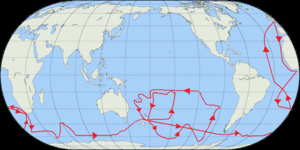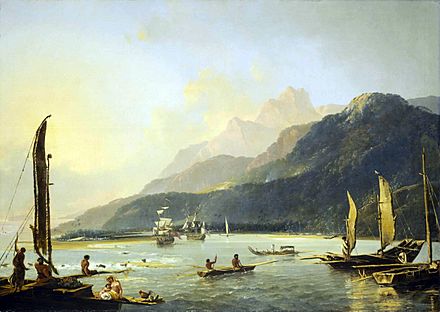Second voyage of James Cook facts for kids
The second voyage of James Cook, from 1772 to 1775, was a big adventure. The British government asked James Cook to lead it. They wanted to find out if a huge southern landmass, called Terra Australis, really existed.
On his first voyage, Cook had sailed all around New Zealand. He proved it was not connected to a larger southern land. He also mapped much of eastern Australia. But some people, like Alexander Dalrymple from the Royal Society, still believed a massive southern continent was out there.
After some delays, two ships were ready: Resolution and Adventure. They set sail for the Antarctic in July 1772.
On January 17, 1773, Resolution was the first ship to cross the Antarctic Circle. This happened two more times on this trip. On February 3, 1774, they reached their furthest south point: 71°10′ South. Cook sailed across huge parts of the Pacific Ocean. He proved that Terra Australis was just a myth. He sailed over most of the places where people thought it would be.
During his journey, Cook visited many places. These included Easter Island, Tahiti, the Tonga Islands, and New Caledonia. He even named many of them. Cook showed that the idea of an unknown southern land was wrong. He also guessed that a land like Antarctica would be found beyond the ice.
On this voyage, a special clock called the Larcum Kendall K1 chronometer was used. It helped William Wales figure out their exact position at sea. Wales kept a detailed logbook. He wrote about locations, weather, and how the instruments worked. He also made many notes about the people and places they met.
Contents
Why the Voyage Happened
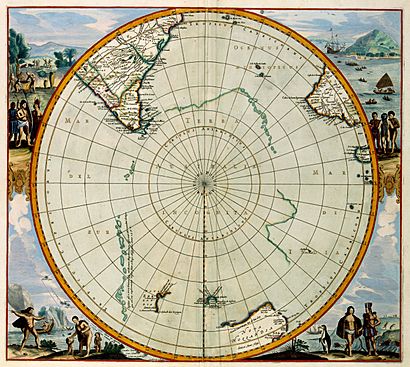
In 1752, a member of the Royal Society of London, Alexander Dalrymple, found something interesting. He was translating old Spanish papers. He found proof from Luis Váez de Torres that there was a passage south of New Guinea. This passage is now called Torres Strait.
This discovery made Dalrymple write a book in 1770–1771. It was called An Historical Collection of the Several Voyages and Discoveries in the South Pacific Ocean. This book made many people believe in a huge, unknown continent. After his first voyage in 1771, Commander Cook was asked to lead a second trip. The Royal Society wanted him to find this supposed southern continent, Terra Australis Incognita.
Getting Ready for the Trip
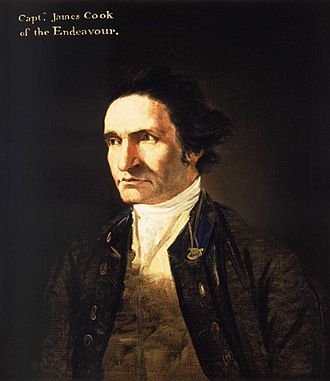
Ships and Supplies
Cook was the captain of HMS Resolution. The other ship, HMS Adventure, was commanded by Tobias Furneaux. Resolution started as a coal ship called Marquis of Granby. The Royal Navy bought her in 1771. She was made stronger and given new equipment. She was 111 feet (34 meters) long. She was first named HMS Drake, but was changed to Resolution to avoid upsetting the Spanish.
Resolution was fitted with the best tools for sailing. This included a special compass and tools to make fresh water from sea water. She also carried 12 light guns. Cook even paid for some brass door hinges himself!
HMS Adventure was also a coal ship before the Navy bought her. She was 97 feet (30 meters) long and carried ten guns. Both ships were built in Whitby.
Cook was asked to test the Larcum Kendall K1 chronometer. This was a very accurate clock for finding longitude at sea. It was a copy of a famous clock made by John Harrison. The Kendall clock worked very well. Three other clocks were also brought, but they broke during the tough journey.
The ships were loaded with lots of food. This included biscuits, salted beef and pork, beer, and spirits. To prevent scurvy (a disease from lack of vitamin C), they took nearly 20,000 pounds (9,000 kg) of sauerkraut. They also had livestock like cows, sheep, and chickens. The crews had fishing gear. They also had a system to clean sea water for drinking. They brought knives, axes, beads, and ribbons to trade with local people.
Who Else Was On Board?
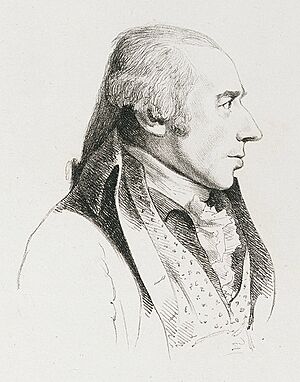
Captain Furneaux, from Adventure, was an experienced explorer. He had sailed around the world before. His crew included 81 people, plus 12 marines. William Bayly was the astronomer on Adventure.
At first, the famous naturalist Joseph Banks was supposed to go with Cook. The ship Resolution was even changed to suit him. But the changes made the ship too heavy. So, they had to remove them. Banks then decided not to go. Instead, Johann Reinhold Forster and his son, Georg, joined as scientists.
Resolution had a crew of 112. This included officers like Charles Clerke and young sailors like George Vancouver. William Wales was the astronomer. William Hodges was the artist. In total, there were 90 sailors and 18 marines, plus other specialists.
The Journey Begins
Cook's second voyage started from Plymouth Sound on July 13, 1772. Their first stop was Funchal in the Madeira Islands on August 1. Cook was very happy with his ship. He wrote that Resolution "steers, works, sails well and is remarkably stiff." They restocked with fresh water, meat, and vegetables. After another stop in the Cape Verde Islands, they sailed south.
They reached Table Bay in South Africa on October 30. The crew was healthy because Cook made sure they ate well and kept the ship clean. Here, a botanist named Anders Sparrman joined the trip.

The ships left South Africa on November 22, 1772. They headed for the South Atlantic. A French sailor named Bouvet had claimed to see land there. Soon, they faced very cold weather. By early December, they were sailing in thick fog and seeing 'ice islands'. Cook did not find the island Bouvet had described. Ice surrounded the ships. But in January, the weather improved. Cook was able to sail south through the ice. They crossed the Antarctic Circle on January 17. The next day, heavy ice forced them to turn north.
On February 8, 1773, Resolution and Adventure got separated in the Antarctic fog. Furneaux, on Adventure, sailed to their planned meeting spot. This was Queen Charlotte Sound in New Zealand. On the way, Adventure explored the southern coast of Tasmania. Furneaux made the first British map of this coast. But he thought Tasmania was part of mainland Australia. Adventure arrived at Queen Charlotte Sound on May 7, 1773.
Cook kept exploring southeast. He reached 61°21' South on February 24. In mid-March, he decided to go to Dusky Bay (now Dusky Sound) in New Zealand. The ship rested there until April 30. Resolution reached Queen Charlotte Sound on May 17, where Adventure was waiting.
From June to October, the two ships explored the southern Pacific. They reached Tahiti on August 15. A man named Omai from Ra'iatea joined Adventure there. Omai later became one of the first Pacific Islanders to visit Europe.
After visiting Tonga, the ships returned to New Zealand. But a storm separated them again on October 22. This time, they missed each other at Queen Charlotte Sound. Resolution left on November 26. Adventure arrived four days later. Cook had left a message buried in the sand. It explained his plan to explore the South Pacific and return to New Zealand. Furneaux decided to go home instead. He buried a reply saying so. In New Zealand, Furneaux lost some men in a fight with Māori. He then sailed back to Britain, arriving on July 14, 1774.
Cook continued to explore the Antarctic. He sailed south into the summer ice, icebergs, and fog. He reached 67°31′ South before turning north. He crossed the Antarctic Circle a third time on January 26, 1774. This led to his furthest south point: 71°10′ South on January 30. They could not go any further because of solid sea ice. Cook wrote that he wanted to go "as far as it was possible for man to go." He was not sad to be stopped by the ice.
The ship then sailed north across a huge part of the Pacific Ocean. They reached areas near the Equator and then New Guinea. Cook landed at the Friendly Islands, Easter Island, Norfolk Island, New Caledonia, and Vanuatu. Then he returned to Queen Charlotte Sound in New Zealand.
The Journey Home
On November 10, 1774, the expedition sailed east across the Pacific. They saw the western end of the Strait of Magellan on December 17. They spent Christmas in a bay they named Christmas Sound in Tierra del Fuego. After passing Cape Horn, Cook explored the South Atlantic. He was looking for another coastline that Dalrymple had predicted. When he didn't find it, they turned north.
They discovered an island they named South Georgia. In a final try to find Bouvet Island, Cook discovered the South Sandwich Islands. Here, he correctly guessed that "there is a tract of land near the Pole, which is the Source of most of the ice."
Later, in February 1775, he said that such a polar continent was "probable." He even wrote in his journal that he "firmly believe[d] it."
On March 21, 1775, Resolution stopped in Table Bay for five weeks to fix its ropes and sails. She arrived home at Spithead, Portsmouth, on July 30, 1775. On the way, she had visited St Helena and Fernando de Noronha.
Returning Home and What Cook Achieved
When Cook returned, his reports ended the popular idea of Terra Australis. Another big success of the second voyage was the use of the Larcum Kendall K1 chronometer. This clock helped Cook figure out his exact position at sea much more accurately. Cook praised the clock highly. He used it to make maps of the southern Pacific Ocean. These maps were so good that people were still using copies of them in the mid-1900s!
Cook was promoted to the rank of captain. He was also given an honorary retirement job at the Greenwich Hospital. He didn't really want to retire. He said he would leave the job if he could go on another active duty trip. His fame grew beyond just the Navy. He became a Fellow of the Royal Society and won a special award called the Copley Gold Medal. He was painted by Nathaniel Dance-Holland and was called "the first navigator in Europe."
Cook's Lasting Impact
Cook's stories about the many seals and whales in the Southern Ocean led to more exploration. Seal hunters went there looking for valuable animal skins. In the 1800s, over a thousand sealing ships traveled to the Antarctic regions.


